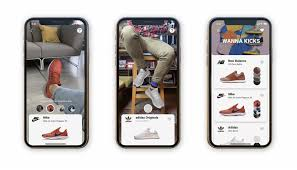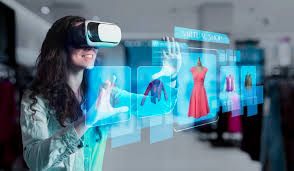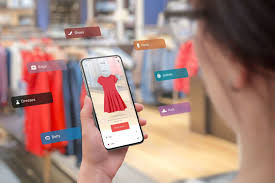Introduction:

Augmented Reality (AR) shopping is an innovative technology that blends the physical and digital worlds, enhancing the way consumers shop. With the help of AR, shoppers can interact with virtual objects in real-time, visualizing products in their environment before making a purchase. This technology is changing the retail landscape by providing a more immersive and personalized shopping experience. As mobile devices and AR technology evolve, AR shopping is poised to become a central aspect of how we shop for clothes, furniture, cosmetics, and even groceries in the future.

How They Work:
AR shopping works by overlaying digital information—such as images, videos, or 3D models—onto the real world through a device like a smartphone, tablet, or AR glasses. The technology typically relies on the device’s camera, sensors, and processing power to track the user’s movements and recognize objects in their environment. Here’s how the process generally unfolds:
- Tracking and Interaction: AR apps detect the user’s surroundings by using the camera or other sensors. For instance, in fashion shopping, it can map the shape and size of a customer’s body to fit clothes virtually.
- Product Visualization: Shoppers can see 3D models of the products displayed on their screen, such as a virtual chair placed in their living room or makeup applied to their face.
- Real-Time Experience: The AR system updates the virtual images as the user moves, allowing them to interact with products from different angles, zoom in, or modify features (such as color or size).
- Checkout and Purchase: Once satisfied with the virtual product, customers can make a purchase directly through the AR app or website, completing the transaction seamlessly.
What Are the Uses:
AR shopping has a wide range of applications across multiple industries. Some common uses include:
Fashion and Apparel: Virtual fitting rooms allow customers to try on clothes or accessories without actually wearing them. AR apps can suggest items that match your style or body type, providing a more personalized shopping experience.
Furniture and Home Décor: AR apps let customers visualize how furniture will look in their own homes, from couches to tables, by superimposing the product onto their living room or kitchen space.
Beauty and Cosmetics: Virtual makeup try-ons allow users to see how products like foundation, lipstick, or eyeshadow would look on their skin tone without applying them physically.
Beauty and Cosmetics: Virtual makeup try-ons allow users to see how products like foundation, lipstick, or eyeshadow would look on their skin tone without applying them physically.
Electronics: Consumers can preview electronics like smartphones, TVs, or speakers in their space to check if they fit with their existing décor or requirement.
Grocery Shopping: AR could potentially be used to help users navigate grocery stores, find items, or even get product recommendations based on their preferences or dietary restrictions.

Advantages:
The integration of AR into shopping brings several advantages to both customers and retailers:
Enhanced Customer Experience: AR provides an immersive and interactive shopping experience, allowing customers to make more informed decisions by visualizing products in their own space before buying.
Increased Engagement: AR engages customers more deeply by making shopping more fun and personalized. This can lead to longer time spent on shopping platforms, increasing the likelihood of a purchase.
Reduced Return Rates: By virtually trying products or visualizing them in real-life settings, customers can get a clearer idea of what they’re buying, leading to fewer returns and exchanges.
Convenience: AR allows for remote shopping without the need to physically try on or see products in person, saving time and effort for customers. This is especially beneficial for people who live in remote areas or are busy with tight scheduled.
Improved Product Understanding: AR provides detailed and interactive information about products, helping consumers understand features, sizes, and colors more easily.

Disadvantages:
While AR shopping offers numerous benefits, there are also some drawbacks:
Technology Barriers: Not all consumers have access to the latest smartphones or AR glasses, which can limit the widespread adoption of AR shopping. Additionally, the technology may not always work seamlessly on older devices.
Technology Barriers: Not all consumers have access to the latest smartphones or AR glasses, which can limit the widespread adoption of AR shopping. Additionally, the technology may not always work seamlessly on older devices.
Limited Availability: AR shopping experiences are still relatively limited in terms of product categories and brands. Many businesses have yet to implement AR technology, which means consumers can’t always enjoy it across all types of purchases.
Limited Availability: AR shopping experiences are still relatively limited in terms of product categories and brands. Many businesses have yet to implement AR technology, which means consumers can’t always enjoy it across all types of purchases
Over-Reliance on Technology: While AR can improve shopping, it might encourage consumers to rely too heavily on virtual experiences, which could reduce the joy of physical store visits or lead to over-consumption through impulse buying.
Future Scope:
The future of AR shopping looks incredibly promising as technology continues to advance. Here are some potential developments:
Increased Integration: AR will likely become more integrated into existing shopping platforms, including e-commerce sites and brick-and-mortar stores. We may see AR-powered storefronts where shoppers can interact with products using AR on their smartphones or AR glasses.
Improved Personalization: AI and AR will combine to provide even more personalized shopping experiences. Future AR apps might use facial recognition or behavioral data to offer hyper-targeted product recommendations, adjusting virtual displays to individual preferences in real-time.
Expansion into More Industries: As AR technology evolves, it will likely be adopted across a wider range of sectors. For example, car manufacturers could offer AR test drives, while travel agencies could use AR to provide immersive previews of vacation destinations.
Augmented Reality Glasses: Instead of using a smartphone, consumers may rely on AR glasses that can seamlessly blend virtual elements with the real world, providing an uninterrupted, hands-free shopping experience. These glasses could display product information, pricing, and interactive displays directly in the consumer’s line of sight.
Social Shopping: The future of AR shopping could include social features, where users can share virtual shopping experiences with friends or even shop together in virtual spaces, mimicking the social experience of going to a store with friends or family.
Voice and Gesture Control: Future AR platforms may allow for voice and gesture controls, making shopping even more intuitive and accessible for all users, including those with disabilities.

